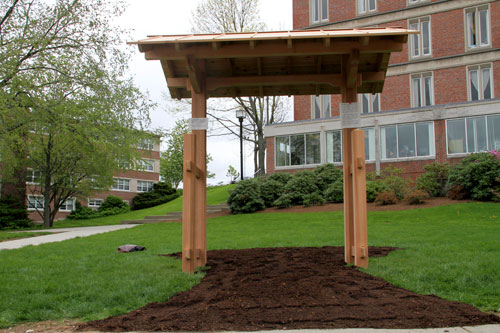A gate constructed out of wood has members of the Holy Cross community doing a double take as they walk past the Hogan Courtyard. The Japanese garden gate was erected earlier in the week. Here are the details.
1. The gate was designed and constructed by a team of students in the Gardens and World Religions course taught by Todd Lewis, professor of religious studies, in conjunction with Charles Krikorian, supervisor of the carpenter shop in the College’s Physical Plant. The gate will be on display until the end of May.
2. Japanese tea garden gates hold much value and meaning. Tea gardens in medieval Japan were built to provide a refuge from the chaotic, messy life in the markets and halls of power, explains Lewis. Because they were built in the cities and in small estates, garden makers used many design features to provide a sense of separation. A garden gate marked the entry into this place of retreat, where drinking strong tea with a few companions would be a time of refined aesthetic experience and, for some, a time of spiritual renewal. Jesuits residing in Japan in the 17th century were so moved by the Japanese traditions of tea that they built tea houses and gardens in their residences.
3. Other small teams of students in the course designed small virtual garden spaces for specific locations on campus, each of which included outdoor class meeting spaces. Their inspiration came from the tradition of gardens associated with religious traditions — Christian monasticism, Renaissance, Chinese and modern. The technical design portion of the course was conducted by Richard Lent, coordinator of Educational Technology, and assistance with the design was provided by noted Japanese garden designer, Marc Keene. “I believe that other students, faculty, and administrators are deeply impressed at the student visions for how to make our campus more beautiful, meaningful, and useful for outdoor classes,” says Lewis.
4. The project fulfills Holy Cross’ growing emphasis on a global curriculum, and enhancing the student experience of campus life. The Holy Cross campus is a natural place for gardens to be built, says Lewis. A quote from Robert Harrison, who authored a capstone course book “Gardens: An Essay on the Human Condition” captured the conclusion of Lewis’s class: "If one conceives of a garden as a retreat of sorts, as Plato did, then one understands why he spoke of educators as gardeners of the soul, and why some of us, whether we consider ourselves his direct heirs or not, think of colleges and universities as among the most precious gardens in the world." Says Lewis: “Our gate erected at this time of year invites graduating seniors to consider the moment they are living: departing into the world of careers and service, leaving the ‘garden’ that Holy Cross has been for them, having worked with faculty to cultivate their minds, imaginations, and souls.” The project was sponsored by the Center for Interdisciplinary and Special Studies, the Dean’s Office, Physical Plant, Educational Technology department, and Professor Lewis.
5. A proposed Japanese tea garden on the Holy Cross campus, has been approved by the College’s Board of Trustees, and is pending external funding. In addition to placing an authentic and beautiful Japanese cultural space on campus, the small teahouse and multipurpose hall will provide a venue for tea ceremony, meditation, and classroom seminars, says Lewis, an internationally recognized authority on Buddhism and recent recipient of a Guggenheim Fellowship.
[gallery orderby="title"]
Photography by Christian Santillo
Photo Gallery: Students, Staff Design and Construct Japanese Garden Gate
5 things you need to know about the structure
Read Time
3 Minutes
